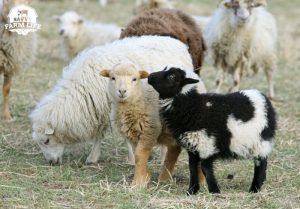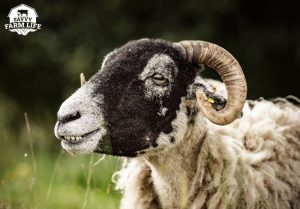
What is the Average Lifespan of Sheep?
When raising livestock, you will need to consider the lifespan of the animal before determining whether they are ready for the commitment. Some livestock, like cows and alpacas, can live up to twenty years, while horses have an even longer lifespan. If you are considering raising sheep, you will need to know how long you can expect them to live.
How long do sheep live? Domestic sheep have a potential lifespan of 10 – 12 years, though most are culled before they reach old age. Wild bighorn sheep have a similar lifespan of 10 – 15 years. If provided a healthy lifestyle and ample forage, sheep can continue to produce healthy lambs into their last years of life.
You may be considering raising sheep as pasture pets, or you may be considering sheep as an investment. Either way, a sheep will live longer and remain productive for a longer length of time when properly cared for. Read on to learn more about a sheep’s lifespan, reproduction as it relates to age, and steps you can take to keep your sheep healthy in old age.
How To Extend The Life Of Your Sheep
If your sheep are healthy and provided with proper nutrition, you can keep your sheep happy and productive further into her years than she would otherwise be. Common causes of early death in sheep are bloat, parasitic infections, and predators.
Protecting Your Sheep From Bloat
Bloat is often fatal to sheep, and once you spot the signs of bloat, it is usually too late. Bloat is the accumulation of excess gas in the sheep’s rumen. There is little that you can do to prevent bloat. After all, the most commonly-named contributor is rich, high-protein grasses like alfalfa, which is also one of the most commonly-named contributors to healthy lambs and productive ewes. By avoiding rich, high-protein grass you may be providing the proverbial cure that is worse than the disease.
One step you can take to protect your sheep from bloat is to make sure they are eating at consistent times and in consistent amounts. If your sheep are used to living on poor pasture or hay alone, don’t move them to a rich and plentiful pasture without a slow introduction. Some farmers also blame bloat on wet grass. Though there is little scientific evidence to back this up, you might choose to wait until the morning dew has evaporated from the pasture before turning out your sheep.
Protecting Your Sheep From Parasites
Parasitic infections can wreak havoc in a herd, especially if the sheep are not already healthy and of an ideal weight. Fortunately, we can help protect our sheep from parasites through the use of modern medicine. Depending on the region in which you live, you will want to regularly de-worm and vaccinate your sheep. Some parasites are more prevalent in some areas of the world, so it is best to consult with a veterinarian or experienced sheep farmer to discuss which vaccines and de-wormers are best for your herd. I know that the area I live in is recommended to de-worm sheep on a monthly basis.
Protecting Your Sheep From Predators
Because sheep are relatively defenseless, there are predators in nearly every region in which sheep are raised. Sheep predators include coyotes, wolves, bears, mountain lions, and domesticated dogs. You will want to make sure to protect your sheep. While sheep do not typically test fences, you will want to provide an adequate fence to protect them against predators – this is most commonly achieved by the use of electric fences. You can also raise a livestock guardian with your sheep, such as a livestock guardian dog, donkey, or a llama. A bonus of protecting your sheep is that they will experience fewer incidences of stress. Stress can have a large impact on sheep, and can even lead to death in and of itself.
How Can You Tell A Sheep’s Age?
 As is the case with many animals, a sheep’s teeth can tell you a lot about its age. In the absence of records, a sheep’s teeth will be assessed to determine how old the sheep is. While you may initially need help from a vet or experienced sheep farmer to assess teeth, with practice you will be able to read your sheep’s dental health like a professional.
As is the case with many animals, a sheep’s teeth can tell you a lot about its age. In the absence of records, a sheep’s teeth will be assessed to determine how old the sheep is. While you may initially need help from a vet or experienced sheep farmer to assess teeth, with practice you will be able to read your sheep’s dental health like a professional.
Sheep do not have a full set of teeth until they are approximately 4 years old, and this set of teeth is limited to incisors in the front lower jaw and molars in both the upper and lower jaws. Sheep do not have upper incisors, and instead have a “dental pad” in the front of the upper jaw which is a thick, gummy pad. Sheep have 32 teeth in total.
Dental Development In A Young Sheep
While every sheep is an individual, their oral development follows a standard order. When a lamb is born, he will have eight milk teeth that are temporary incisors. By the time they reach 1 year of age, their two front lower teeth will be replaced by permanent incisors. When they reach 2 years of age, the next two teeth are replaced by permanent incisors. At 3, the third pair of baby teeth are replaced by permanent teeth. And by 4, all of their teeth will have been replaced by adult incisors.
Because a young sheep’s teeth are replaced annually in pairs, determining a sheep’s age is relatively straight-forward during the first 4 years of life. The permanent incisors are significantly larger than the milk teeth, which helps to provide the distinction necessary for assessment. As they get older, determining a sheep’s age by the condition of their teeth becomes a less exact science.
Dental Conditions In Older Sheep
After around four years of age, a sheep’s teeth will begin to deteriorate with time. The sheep’s incisors will slowly start to spread, wear, and even break. Sheep with broken teeth are known as “broken-mouthed” sheep, and those with no teeth are termed “gummies”. While sheep without teeth can continue to chew and eat, they will have a difficult time eating enough to sustain a healthy weight, especially when pregnant or nursing, and are therefore often culled from the herd.
Both genetics and environment will play a role in dental condition. Some breeds of sheep have a higher prevalence of broken teeth at a younger age. You might raise two sheep of different breeds in the same conditions, and one sheep will have broken teeth at 5 years of age, while the other will not have broken teeth until 8 years of age. Environment and nutrition also have a big impact on dental health – those raised in harsh conditions or on dirt will have more wearing of the teeth than sheep raised on plentiful pasture.
How Old Is Too Old For Sheep Production?
Sheep are typically raised for milk, meat, and wool. Those raised for meat are generally processed at a young age due to quality and tenderness. Unlike meat, both milk and wool are products that are derived from live animals. A ewe who produces healthy lambs is essential for production and profitability.
Ewes reach their reproductive peak between the ages of 3 and 6 years old. While there are many stories from farmers about sheep producing healthy lambs past the age of 10, most sheeps begin to experience a decline in production after the age of 7. For this reason, many ewes – particularly those in larger operations – are culled around the age of 7.
While there are physiological reasons that a ewe’s ability to reproduce will begin to decline with age, another factor that comes into play is dental health. As explained earlier, when a ewe has broken teeth, she will find it more difficult to take in enough calories to sustain a healthy weight. This will become even more of a problem if she is producing, feeding, and raising a lamb. Ewes require additional calories to maintain milk production, and without ample milk, a lamb will not thrive.
To learn more about pregnancy in sheep, visit my article How to Tell if a Sheep is Pregnant: Sheep Pregnancy Guide.
How Old Was The Oldest Sheep?
If you follow the above advice for your sheep, you will have a higher likelihood of raising your sheep to the ripe age of 10 or 12, though you may be surprised with an outlier who reaches up to 20 years of age.
The oldest sheep on record was a crossbred ewe who lived to the age of 28 years and 51 weeks (in other words, just a few days shy of 29 years). She produced 40 lambs in her life, with her last healthy lamb born to her when she was 28 years old.
Another close contender for the title was Methuselina, who lived to be 25 years and 11 months old. Her owner contributed her longevity to being able to graze easily due to her full mouth of healthy teeth. Who knows how long this full-mouthed ewe could have lived – she died in 2009 after she fell off a cliff.
As you can see, dental health is the key to helping your sheep reach its potential lifespan. With good genes and a healthy environment, your sheep has the potential to live and produce lambs for more than a decade.
Did you know that sheep can live just as long in the wild as they can in domestication? Wild sheep are pretty hardcore! To learn more about the lifestyle of wild sheep, visit my article Can Sheep Survive in the Wild? Wool Growth and Behavior Guide.
